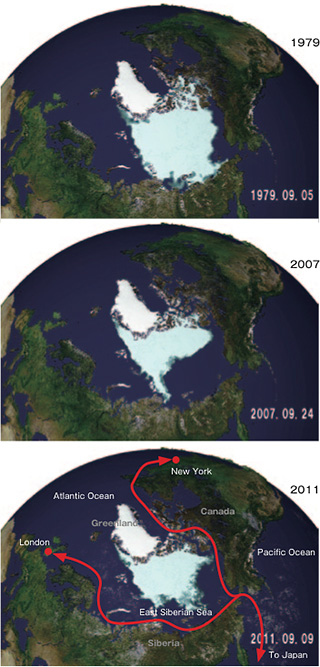Strategic Research Target ④
Projection of sea ice distribution and Arctic sea routes
Principal Investigator : Koji Shimada (Tokyo University of Marine Science and Technology)
Linking the Pacific and Atlantic by the shortest route
Environmental changes in the Arctic Ocean have already stretched beyond the frame of a scientific problem, and are attracting social attention. The reduction of the sea ice area is expected to make the Arctic sea routes useable, which will be the shortest link between the Pacific and Atlantic Oceans. Under these circumstances, understanding of the dynamics of Arctic sea ice is absolutely essential for the safe use of the Arctic Ocean.
The following research projects are being carried out to achieve strategic research target ④ Projection of sea ice distribution and Arctic sea routes.
a. Changes in the Arctic Ocean and mechanisms of catastrophic reduction of Arctic sea ice
The reduction of Arctic sea ice has accelerated beyond the prediction of any climate model; the mechanism of the reduction is, however, still unclear. The mechanisms of the Arctic sea ice reduction must be elucidated urgently in order to build an Arctic sea ice forecasting system. In sub-project (a), we will clarify the mechanisms of the Arctic sea ice reduction based on insitu observations and satellite data from Japan Aerospace Exploration Agency. Through a series of joint observations with overseas Arctic research observational agencies, the GRENE Arctic Climate Change Research Project is using foreign icebreakers that are essential for insitu observations in the Arctic Ocean. These in-situ observations include hydrographic observations and also utilize moored observation systems that can measure sea ice movement and thickness, the water temperature, salinity, and the direction/speed of ocean current under the sea ice.
b. Sea ice prediction and construction of an ice navigation support system for the Arctic sea routes
An area of navigable water appears only during summer time when the Arctic sea ice shrinks. By early spring when shipping schedules are planned, people need to know when the Arctic Ocean will be ice-free. Since the sea ice distribution is changing constantly, scientists are building a system to predict sea ice on a daily to monthly time scale.
A numerical model of the Arctic Ocean is required for highly accurate sea ice forecasts. To this end, scientists are developing a model that can reproduce the complex oceanic structure involving the Pacific Ocean, Atlantic Ocean and various rivers, and simulate the development of sea ice and oceanic structures. Scientists will use this model to build a system to predict Arctic sea ice distribution over a scale that will range for a season to several decades.

Distribution of sea ice on the day when its total area of coverage is at a minimum and Arctic sea routes (AMSR-E data, Source: JAXA)
Expected results
Clarifying the mechanism for the rapid reduction of sea ice and building a model for the oceanic structure of the Arctic Ocean will contribute to the building of a forecasting system for Arctic sea ice. This will enable people to determine the feasibility of the Arctic sea routes.

